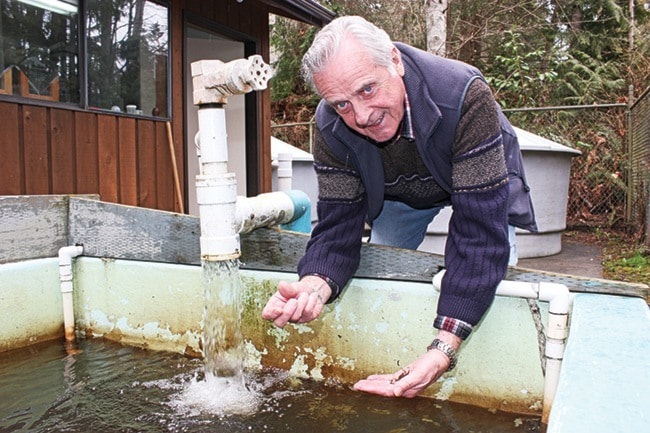Parksville resident Herman Vanderbyl is putting the call out to sports fishermen in the area to consider volunteering at the Marion Baker Fish Hatchery in French Creek.
"We are creating a fishery for sports fishermen. I would hope that some of the avid sport fishermen would be interested in their own hobby enough to provide some support to this project," he said.
Vanderbyl has been one of a handful of dedicated volunteers ensuring the success of the hatchery since it was constructed in 1982 and he said their work over the years has resulted in a healthy salmon fishery in French Creek.
The facility, located on Miller Road, was constructed with voluntary labour by members of the Parksville Qualicum Fish and Game Association with funding from the Salmonid Enhancement Program (SEP) of the Fisheries and Oceans Canada (DFO).
Today, it is an important part of the overall British Columbia SEP and for more than 30 years it has been operated 100 per cent by volunteers.
At a recent open house at the hatchery, Vanderbyl explained that there are many steps through the hatchery a new salmon must take before it is released in to the wild and that takes huge amount of work and dedication from volunteer members.
"I am here every Monday. If I can't make it I have to find a replacement ... especially when it is feeding time. It is a big commitment," he said.
Vanderbyl is one of about a dozen volunteers who work year round at the hatchery and although it is a labour of love for him he said the more laborious duties are starting to take its toll on him and the other old-timers who run the operation.
"When I helped build the hatchery I was 49 years old. Now most of us have white hair."
He pointed out that in the fall a group of volunteers must hike down a 100 foot bank to capture the returning salmon and bring them back to the hatchery in totes.
"It is a big grind. That part used to be easy but I am 81 years old this year and now it is difficult. Now I can only carry one fish because they weight between eight and ten pounds. We need some young volunteers," he agreed.
The capture of the returning salmon and the stripping of eggs is just the first phase of all hatchery operations.
After the eggs are stripped from the salmon they are fertilized and transferred to incubation trays where they are left for some months.
They are moved to larger trays as they develop from the egg stage through to small finger size fish.
During this time they must be monitored constantly because any change in temperature or oxygen can be fatal.
Vanderbyl said their members are on call 24 hours a day to respond to any issues or emergencies that arise at the hatchery.
Before salmon can be released into the wild each one must have their adipose fin removed and that is a big job.
Vanderbyl said they clip the fins to distinguish returning hatchery-raised fish from wild runs of salmon which helps DFO personnel get a better feel for the health of the wild fishery.
He said it takes a lot of work to raise fish and members must keep detailed records of things like water temperature and the times filters were changed.
In late spring the fingerling sized young salmon are ready to be released into the wild.
This is when the volunteers get their reward as they watch the young fish swim out of the buckets into their new home at the head of French Creek, the same stream from which their parents were captured many months ago.
Vanderbyl said this is not the end of the work however as often the fish will need additional feeding until they can survive alone.
He said their goal is to get 30,000 Coho hatched each year.
That figure is an objective from DFO because more than that could overcrowd the creek. Vanderbyl said their work is paying off because over the last two years the creek has seen some impressive returns of Coho and Chum salmon.
"I have seen four to six Coho at a time going up the rapids, so we are getting some good returns."
He said all the tasks they must perform may appear overwhelming but with a lot of hands it makes the job easier.
Anyone interested in volunteering at the hatchery can call Vanderbyl at 250-248-3908.
